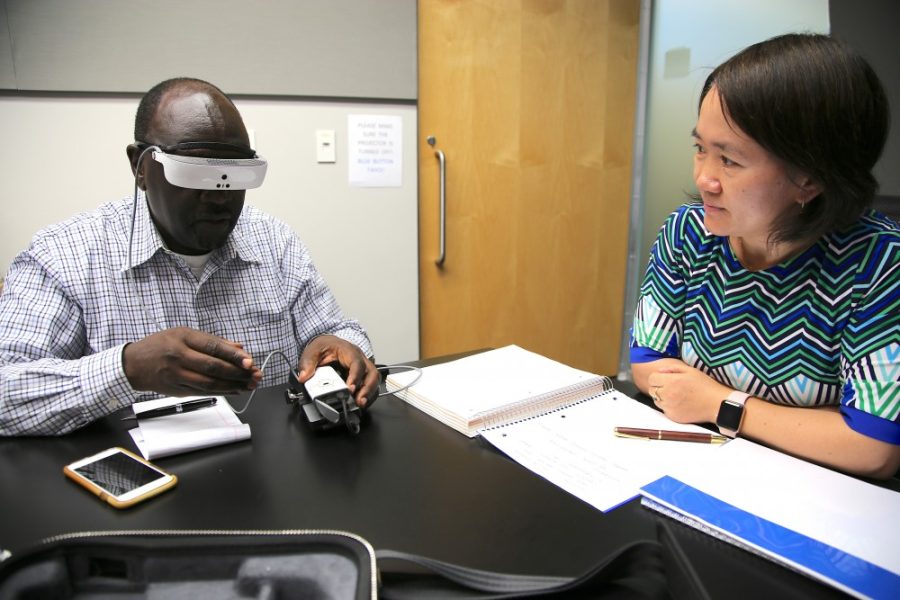Hong Hua, an optical sciences professor at the University of Arizona, helped develop the technology to invent a pair of high-resolution goggles that helps legally blind people see. She and a graduate student, Jason Kuhn, worked with eSight Corporation to release this innovative product to the public.
Daily Wildcat: What kind of technology did you invent?
Hong Hua: So, the technology that we developed for this Canadian company eSight was actually done a couple years ago with the idea, we call it a goggle, to help people with severely deviated and degraded vision, legally blind they may say. They are not able to read a regular size of the text or even not being able to recognize your face at this distance. They can only read the biggest level on the eye chart or maybe not even that.
DW: How does the technology work?
Hua: This technology, when you put it on, has cameras and a light sensor and the camera captures the environment or even someone talking to you. So I can put this on and this will take pictures of you and that video will be fed to the computer system and that will also connect them to very small pixels— we call them micro displace— and that functions like your monitor. And then, the core-piece was the optics that we designed for them.
The optics are going to magnify the image and project it into space and so you can see that at a comfortable distance. And then the control system here would allow you to, for example, zoom or magnify the pictures at a significantly larger magnification ratio so that your face would appear much bigger.
So, you can imagine a person with very low vision, they would be able to magnify the picture and be able to see your face at a larger scale, about two to three times bigger, so they can read a text. And then some people not only had compromised vision, but they also are not able to read the contents with the regular contrast, so they might be able to read when the image is a higher contrast.
RELATED: Q&A: $20 million endowment to College of Optical Sciences
DW: How did you come up with the idea for this?
Hong: I have been working on this type of technology for a long time, but not necessarily this particular application. We have been developing optics technology for virtual reality and augmented reality applications and we’ve developed different types of systems before this one.
What’s intriguing to me is that I was approached by a very small company and they had this idea to assist people with vision problems, and I was fascinated by the application to do something that could help them develop something that helps people improve their quality of life and live more independently and I thought it was a very cool thing to do.
DW: What was the end cost?
Hua: The end cost was around $10,000 to $15,000 for users and I think today it’s $5,000 to $6,000. I’m sure as users adopt the technology, the cost will go down.
DW: What was the biggest challenge?
Hua: The biggest challenge for us actually was designing optics to match their specific was difficult because this was the first time using this type of design and pixels.
The requirements on the optics technology is demanding because you want the pixels to be small and you want an end image quality to be high and also allow the room to magnify, and so that imposed a big challenge for us. The other challenge was to design them, fine-tune, demonstrate and then hand the design off to the industry.
RELATED: NASA chooses UA for MIRO program
DW: How did you get interested in optics technology?
Hong: To be in honest, when I got into college, I wanted to study science and technology. And at the time, what fascinated me was astronomy and I wanted to develop telescopes. As a child, that’s the only thing I knew about.
I chose to study optics when I went to college and I went to a university that had a really good optics program in China … I never got the chance to get into telescopes, but I wanted to get my hands into virtual reality, so I started going into this specialized optics technology.
DW: Did you think you think it would go into helping legally blind people?
Hong: No, I didn’t think so. But since I started as a professor at the U of A, I was always fascinated about applying my research to a more practical application that can help people.
DW: What could a student do if they wanted to invent something to help people in need?
Hong: I always say to students that optics is universal, and if you have in mind that you want to help people to do things better, you can always find a way to do it. I think most of the time, when the opportunity presents itself in front of you, you grab it and you do it.
Follow Alana Minkler on Twitter















